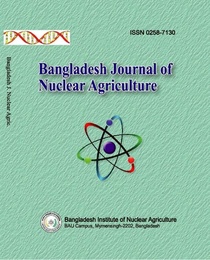DETERMINATION OF OPTIMUM DOSE AND TIME OF FOLIAR APPLICATION OF BORON FOR INCREASING YIELD OF BRINJAL (Short communication)
Abstract
A field experiment was carried out at Bangladesh Institute of Nuclear Agriculture (BINA) sub-station farm, Magura during Rabi season of 2020-21. The objective of the experiment was to determine the optimum dose and time of foliar application of Boron. The treatments were viz., 0.5g B L-1 .H2O at vegetative stage, 1.0g B L-1.H2O at vegetative stage, 0.5g B L-1.H2O at vegetative stage + g B L-1.H2O at Fruiting stage, 1.0g B L-1.H2O at vegetative stage + 1.0 g B L-1.H2O at Fruiting stage, 1.5g B L-1.H2O at vegetative stage, 1.5g B L-1 L.H2O at vegetative stage + 1.5g B L-1. H2O at Fruiting stage, 2.0g B L-1.H2O at vegetative stage, 2.0g B L-1.H2O at vegetative stage + 2.0g B L-1.H2O at Fruiting stage and control. The experiment was laid out in a randomized complete block design (RCBD) with three replications. The Plot size of the experiment was 3m × 2m. Various parameters were influenced significantly by different concentrations of boron except for plant height. Maximum number of branches (5.07 plant-1), number of fruits (25.67 plant-1), fruit length (11.47 cm), single fruit weight (185.80g) and fruit yield 5.33 kg plant-1 and 10.66 t ha-1) were found from foliar application of boron with 1.0g B L-1.H2O at the vegetative stage and 1.0g B L-1. H2O at the fruiting stage while minimum from control. The study suggested that foliar application of boron with 1.0g B L-1.H2O at the vegetative stage and 1.0g B L-1.H2O at the fruiting stage could be recommended to get maximum yield of brinjal.
References
Ashoori, M., Lolaei, A., Zamani, S. & Mobasheri, S. 2013. Effect of N and Zn on quantity and quality characters of grapevine (Vitisvinifera). Int. J. Agri. Crop Sci., 5(3), 207-211.
BBS (Bangladesh Bureau of Statistics) .2021. Statistical Year Book of Bangladesh. Planning Division. Ministry of planning. Government of the People's Republic of Bangladesh. Dhaka. pp. 281-337.
Basavarajeswari, C.P., Hosamni, R.M., Ajjappalavara, P.S., Naik, B.H., Smitha, R.P. & Ukkund. 2008. Effect of foliar application of micronutrients on growth, yield components of Tomato (Lycopersiconesculentum Mill). Karnataka J. Agri. Sci., 21(3), 428-430.
Bliss, R.M., & Elstein, D. 2004. Scientists get under egg plants skin. ARS magazine, January, 52 (1).
Caguiat, X.G.I., & Hautea D.M. 2014. Genetic diversity analysis of egg plant (Solanummelongena L.) and related wild species in the Philippines using morphological and SSR markers. Sabrao Journal of Breeding and Genetics, 46(2), 183-201.
Chaudhary, P.K., and Saraf, R.K. 1996. Influence of growth regulators and insecticides on growth & yield of brinjal (Solanummelongena L.). Orissa Journal of Horticulture,20 (2), 42- 47.
Davis, J.M., Sanders, D.C., Nelson, P.V., Lengnick, L. & Sperry, W.J. 2003. Boron improves growth, yield, quality and nutrients contents of tomato. J. Am. Soc. Hort. Sci., 128(3), 441-446.
Gotame, T.P., Poudel, S., Lal Shrestha, S., & Shrestha, J. 2020. Evaluation of Yield and Yield Components of Eggplant (Solanummelongena L.) Genotypes in the Terai Region of Nepal. International Journal of Environment, 9(2), 67-80.https://doi.org/10.3126/ije.v9i2.32517
Halfacre, R.G. and Barden, J.A. 1979. In: Horticulture. McGraw Hill Book Co.USA.
Islam, A. 1992. Review of soil fertility Research in BD. In: Proceedings of the Inter-congress conference of commission IV of ISSS on Improving Soil Management for Intensive Cropping in the Tropics and Subtropics. pp: 1-18.
Jahiruddin, M., Hoque, M.S., Haque, A.K.M.M. and Roy, P.K. 1992. Influence of boron, copper and molybdenum of grain formation in wheat. Crop Res., 5: 35-42.
Khayyat, M., Tafazoli, E., Eshghi, S. & Rajaee, S. 2007. Effect of Nitrogen, Boron, Potassium and Zinc Sprays on Yield and Fruit Quality of Date Palm. American-Eurasian Journal Agriculture & Environ. Sciences, 2(3), 289-296.
Kumar, N.M., Pandav, A.K., & Bhat, M.A. 2016. Growth and yield of solanaceous vegetables in response to application of micronutrients: A Review. International Journal of Innovative Science, Engineering & Technology, 3(2), 611-626.
Mustafa, E.A.M., El-shamma, M.S. & Hagass, L.F. 1999. Correction of boron deficiency in grape vines of Bez El-Anze cultivar. American-Euransian J. Agric. & Enviro. Sci., 1(3), 301- 305.
Sindhu, P.C., Ahlawat, V.P. & Nain, A.S. 1999. Effect on yield and fruit quality of grapes (Vitisvinifera L.) cv. Perlette. Haryana J. Hort. Sci., 28(2), 19-21.
Singram, P. & Prabhu, P.C. 2001. Effect of zinc and boron on growth and quality of grapes cv. Muscat. Madras Agriculture Journal, 88(4-6), 233-236.
Shukha, A.K. 2011. Effect of foliar application of calcium and boron on growth, productivity and quality of Indian gooseberry (Emblicaofficinalis). Indian J. Agric. Sci., 81(7), 628-632.
Wojcik, P. & Wojcik, M. 2003. Effects of boron fertilization on conference pear tree vigor, nutrition, and fruit yield and storability. Plant and soil, 256, 413-421.
-
Download



